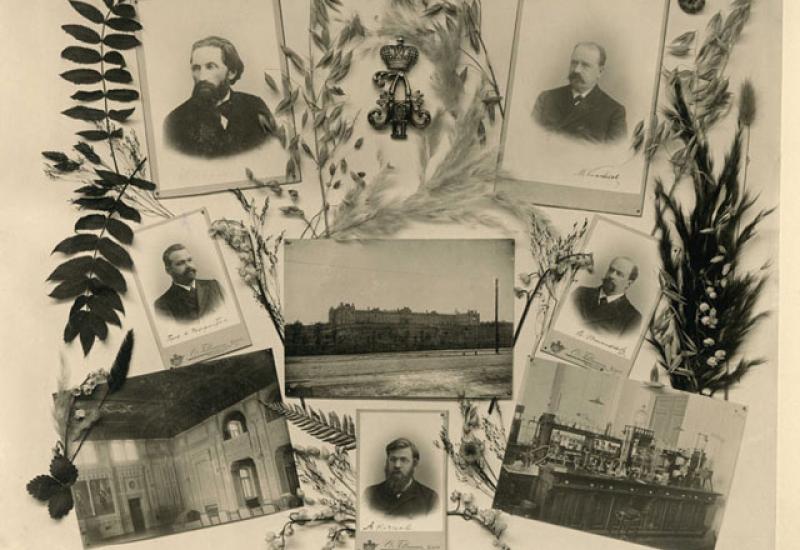The department of physical chemistry of the KPI was established 105 years ago. As science and university subject physical chemistry was just born then, and was the first such department in the Russian Empire. Not only the name but also the themes of the department seemed unusual then.
The founder of the department professor V.F. Timofeyev began developing a new direction such as physics and chemistry of non-aqueous solutions, in which instead of the usual for that time chemists water various organic liquids were as a solvent. In 1904 V.F.Tymofyeyev published the work called "On the heat of formation of non-aqueous solutions". There he experimentally confirmed the presence of chemical interaction between the components of the formation fluids and denied widespread views on the solvent as indifferent environment.
From 1909 to 1941 well-known academician V.A. Plotnikov headed the department of physical chemistry. His PhD thesis, defended in 1909, was called "Studies on electrochemistry of non-aqueous solutions." Plotnikov brought the conductivity of many non-aqueous solutions and established the influence of solvent on the electrode potentials and electrochemical voltage series on a large experimental material already in his first works. Many works of Plotnikov and his collegues were dedicated to the processes of the electrolysis of molten metals and non-aqueous solutions. The researches of metal plating from complex non-aqueous electrolyte solutions were continued in the works of Professor A.K. Cudry, who headed the department from 1944 to 1975.
From 1975 to 1999 the department was headed by Professor Yu.Ya. Fialkov. He started the creation and development of two original scientific fields: quantitative physical-chemical analysis and thermodynamics equilibrium and transport processes in non-aqueous solutions. Continuing the tradition of scientific department, Yu.Ya. Fialkov focused on the non-aqueous electrolyte solution in his studies, including one that were used in chemical power sources - lithium cells and lithium-ion batteries, which have become extremely widespread used in technology and everyday life in recent years.
Today the Department of Physical Chemistry headed by prof. Yu.A.Malyetin. Under his leadership, the department of molecular energy storage laboratory conducted the development of supercapacitors, which again non-aqueous electrolytes. The energy density of supercapacitors is three levels higher than conventional capacitors, but lower than current batteries. But power density of the supercapacitors is higher than batteries’ one. Besides efficiency is about 95%. And the number of charge/discharge cycles of supercapacitors run into the hundreds of thousands.
Professor Yu.A. Malyetin says:
"Recently, the field of application supercapacitors usage is rapidly growing. They are replacing many devices, and come to assist traditional batteries in most cases.
Japanese company NEC placed small supercapacitors parallel with Li-ion batteries in digital cameras, cell phones and laptops. Supercapacitors provide work during peak loads, so battery life increased by 50-80%.
The German company AEG uses supercapacitors to smooth out peak loads on batteries in portable electric drills and other household electrical engineering. Previously, if the drill encountered a solid plot, it would jam, because the battery could not cope with the increased load, now supercapacitors undertakes increased loads and drill goes smoothly.
The beginning of the XXI century was marked by the appearence of the first commercial electric car Honda FSH, which is feed with the electric fuel cell. Battery is working for a long time, and "filling" is reduced to the replacement of a small cylinder with hydrogen. But the battery capacity is insufficient to ensure a quick start. Starting engine jerk is provided by a battery of supercapacitors. It is not surprise that many leading automotive companies are engaged in developing supercapacitors such as General Motors, Daimler-Chrysler, Toyota, Opel and others.
Kursk company "Elit" manufactures the supercapacitors for car audio system. Car battery cannot draw beautiful powerful bass with overtones and supercapacitor has no problem with it. Incidentally, they recently signed an agreement with the Malyshev Kharkiv plant on the supercapacitors supply to run diesel engines. Of course, Kharkiv is close to Kursk, but still a pity that until now there was no issue of wanting to organize the producing supercapacitors in Ukraine, especially as the supercapacitors of the KPI surpass its characteristics of not only Kursk, but also Japanese and American, and German.
Our laboratory has developed a battery of supercapacitors for portable welding machine to order one company that can be used in particular during auto repair work.
There are many designers of technique, which may also need to smooth short-term peak loads, in the NTUU "KPI". Our laboratory can develop supercapacitors for any needs (from 0.1 F to 10,000 F).
Recently events give us grounds for optimism. It began with the fact that our projects have won the first contest of the President of Ukraine for young scientists, and Ukrainian contest of high technology which was conducted by US venture (investment) companies through the created company "TECHINVEST" in Ukraine. As a result of competition this work was presented at a special conference in the famous Silicon Valley in California, where it got high marks. We negotiate with "TECHINVEST" about investment and development of works on supercapacitors through a newly created KPI Technopolis. We hope that the original KPI supercapacitors based on non-aqueous electrolytes will make new breakthrough in technology. "

